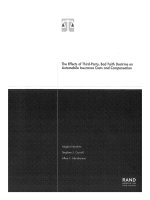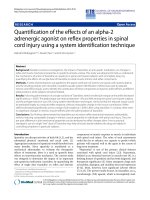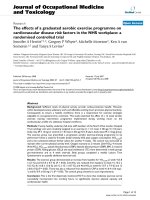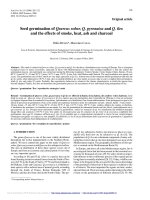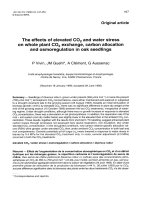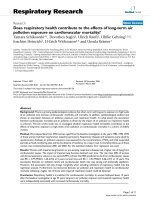The effects of perceived usefulness, confirmation and satisfaction on continuance intention in using massive open online course (MOOC)
Bạn đang xem bản rút gọn của tài liệu. Xem và tải ngay bản đầy đủ của tài liệu tại đây (332.46 KB, 15 trang )
Knowledge Management & E-Learning, Vol.11, No.2. Jun 2019
The effects of perceived usefulness, confirmation and
satisfaction on continuance intention in using massive open
online course (MOOC)
Aisha Aminu Daneji
Ahmad Fauzi Mohd Ayub
Mas Nida Md. Khambari
University Putra Malaysia, Malaysia
Knowledge Management & E-Learning: An International Journal (KM&EL)
ISSN 2073-7904
Recommended citation:
Daneji, A. A., Ayub, A. F. M., & Khambari, M. N. M. (2019). The effects
of perceived usefulness, confirmation and satisfaction on continuance
intention in using massive open online course (MOOC). Knowledge
Management
&
E-Learning,
11(2),
201–214.
/>
Knowledge Management & E-Learning, 11(2), 201–214
The effects of perceived usefulness, confirmation and
satisfaction on continuance intention in using massive open
online course (MOOC)
Aisha Aminu Daneji*
Faculty of Educational Studies
University Putra Malaysia, Malaysia
E-mail:
Ahmad Fauzi Mohd Ayub
Faculty of Educational Studies
Institute for Mathematical Research
University Putra Malaysia, Malaysia
E-mail:
Mas Nida Md. Khambari
Faculty of Educational Studies
University Putra Malaysia, Malaysia
E-mail:
*Corresponding author
Abstract: Massive Open Online Course (MOOC) has been playing an
important role in the latest e-learning initiative and has obtained a widespread
popularity in many universities. However, the low course completion rates of
students have become an outstanding issue that should not be neglected. Based
on the Expectation-Confirmation Model (ECM), this study examines the effects
of students’ perceived usefulness, confirmation and satisfaction on MOOC
continuance intention. Structural Equation Modeling (SEM) was used to
validate the proposed model and hypotheses. Participants were 368
undergraduate students enrolled in a MOOC platform. The study’s result
revealed that confirmation has significant effects on students’ perceived
usefulness and satisfaction. Perceived usefulness and satisfaction have
significant effects on students’ continuance intention while perceived
usefulness has no significant effects on students’ satisfaction. This study will
help to outspread our understanding of what influence students to continue
using MOOC.
Keywords: Massive open online course; Expectation-confirmation model;
Continuance intention; Structural equation modeling; Undergraduate students
Biographical notes: Aisha Aminu Daneji has completed her Master of Science
in Educational Technology at Faculty of Educational Studies, Universiti Putra
Malaysia. She is currently doing her doctoral degree in the same field. Her
research interests include e-learning, and technology-enhanced learning.
Dr. Ahmad Fauzi Mohd Ayub is an Associate Professor in the Faculty of
202
A. A. Daneji et al. (2019)
Educational Studies at Universiti Putra Malaysia. His field of research is related
to information and communication technology in education, mobile learning
and multimedia education. He also assists students to develop multimedia tools
for educational use. Besides that, Dr. Ahmad Fauzi also teach courses at
postgraduate level which includes Computer in Teaching and Learning,
Multimedia and Communication Technology covering both instructional, as
well as educational statistics courses. He has written papers on the use of
learning management systems, integration of computer software in teaching
and learning.
Dr. Mas Nida Md. Khambari is a senior lecturer at the Department of
Foundations of Education, Faculty of Educational Studies. Her research
interests include the use and impact of technology specifically interactive
whiteboards and laptops in education, the Cultural Historical Activity Theory,
and emerging technology trends in education. She has publications in the area
of Educational Communications and Technology.
1. Introduction
Massive Open Online Courses (MOOCs) are lessons delivered in an online environment
whereby, there is an unlimited participation (Marques, 2013; Alraimi, Zo, & Ciganek,
2015). As the use of the internet is now a regular means used by students to search for
information anytime and anywhere (Ifeanyi & Chukwuere, 2018). MOOC are free and
open to any individual who wants to learn online irrespective of his/her place or
education level (Bederson, Russell, & Klemmer, 2015). This may be the reason why
MOOCs have been undergoing a rapid development in recent years (Jordan, 2014;
Konstan et al., 2015). Instructors from everywhere in the world can plan and create
materials on learning points and put them online (Christensen et al., 2013).
Although MOOC have become very popular and used all over the world, the main
issue that cannot be overlooked is the low course completion rate of students (Siemens,
2013; Ouyang et al., 2017). As it is reported in many studies, no more than 10 percent of
the registered students can finish a course on MOOCs (Breslow et al., 2013; Catropa,
2013; Ho et al., 2014; Jordan, 2014). Meanwhile, there is high enrollment but only a few
learners complete their enrolled courses in MOOC, it is therefore important to study the
factors that influence students to continue using the MOOC platform. Additionally, the
review of prior studies revealed that only a few studies examined the MOOC continuance
intention more specifically in the context of Malaysia.
In the previous years, researchers have successfully applied ECM in various
studies to explain continuance intention in several domains. Such as web-based services
(Lee & Kwon, 2011), the use social networking sites (Wang, Xu, & Chan, 2015) and
smartphone banking services (Susanto, Chang, & Ha, 2016). These studies have proved
the validity of the ECM in predicting user’s continuance intention. Therefore, it is an
appropriate theoretical foundation to explain MOOC continuance intention in this study.
As a result, the objective of this study is to empirically test the factors influencing
students’ continuance intention among Malaysian Higher Education students.
Knowledge Management & E-Learning, 11(2), 201–214
203
2. Literature review
Malaysia was declared as the first country in the world to implement MOOCs for all
public universities and the only country where MOOCs were applied at a national scale
through government initiative (Rajendram, 2014). MOOC was initiated by the Ministry
of Higher Education, which was incorporated into the Higher Education system. MOOC
is currently considered as an essential medium for Malaysian universities to disseminate
knowledge conveniently to a larger number of students (Sahimi et al., 2016).
Bhattacherjee (2001) extended Expectation Confirmation Theory (ECT) to build
the ECM in order to understand users’ intention to continue using an information system
(IS). ECT was developed by Oliver (1980) and has been widely used in the marketing
field to measure consumer satisfaction and post-purchase behavior. The ECM postulates
that satisfaction and perceived usefulness are the fundamental factors that affect
continuance intention. Satisfaction is affected by users’ perceived usefulness and
confirmation; perceived usefulness is affected by users’ confirmation (Hossain &
Quaddus, 2012). Bhattacherjee (2001) includes perceived usefulness factor in the ECM
model just as in technology acceptance model (TAM). Perceived usefulness is an
important factor in TAM-based studies as it is the only factor that has been proved to
consistently influence user intention across temporal stages of IS use (Bhattacherjee,
2001). This is why perceived usefulness may be more specific to the context of
information systems and expectations-confirmations that may have a broader context.
ECM has been widely applied in various fields, including the information systems
and e learning. For example, Stone and Baker-Eveleth (2013) used the ECM to study
students' continuance intention with regards to electronic textbooks. The outcome of the
study revealed that confirmation have influence on perceived usefulness and satisfaction,
while satisfaction and perceived usefulness affect continuance intention to use electronic
textbooks. Similarly, Oghuma, Libaque-Saenz, Wong, and Chang (2016) used an
amended ECM to examine continuance intention to use mobile instant messaging. In a
study of continuance intention to using web service with ECM including intimacy and
familiarity, satisfaction was found significant to continuance intention, and both intimacy
and familiarity variables were measured to be also important (Lee & Kwon, 2011).
Similarly, Halilovic and Cicic (2013) extended the ECM to examine the antecedents of
the information systems user behaviour.
With respect to the MOOC domain, ECM has been applied in various MOOC
studies. Such as Xu (2015) who studied MOOCs in China and stated that students’
intention with regards to MOOCs were affected by their subjective norms and by the
perceived usefulness of the course. Similarly, Alraimi et al. (2015) extended ECM to
study continuance intention of MOOC users. Their outcomes showed that perceived
reputation and perceived openness were the strongest predictors of MOOC continuance.
Lately, Zhou (2017) investigated on factors that influence learners’ continuance intention
in MOOC for online collaborative learning in Mainland China. The empirical results of
the study revealed that the effects of the three ECM factors where significant with
learner’s continuance intention. Expectation-Confirmation Model (ECM) was found to be
a convincing model in explaining users’ continuance intention during the past decades
(Bhattacherjee, 2001). It reveals the variables that influence the continuance usage
intention of individuals in the area of information technologies (Dağhan & Akkoyunlu,
2016). The variables include perceived usefulness, confirmation, satisfaction and
continuance intention. Therefore, ECM is considered as an appropriate theoretical
foundation to explain students’ MOOC continuance use intention.
204
A. A. Daneji et al. (2019)
3. Design research model and hypotheses
Based on the ECM model, the proposed model of this study includes all the ECM three
constructs with regards to continuance intention of MOOC use. Fig. 1 showed the
association between the constructs of the study.
Fig. 1. Proposed research model
3.1. Confirmation
Confirmation refers to the opinion of users’ congruence between the expectation of IS
use and its actual performance (Bhattacherjee, 2001). ECM theorizes that the extent of IS
users’ confirmation leads to a positive effect on their perceived usefulness and
satisfaction of IS (Zhou, 2017). Several studies have revealed a direct positive
relationship between users’ confirmation on their perceived usefulness and satisfaction
(Bhattacherjee, 2001; Oliver, 1980; Venkatesh et al., 2011; Alraimi et al., 2015). If users
believe that the IS is very useful and the actual use experience corresponds or goes
beyond their initial expectation, the confirmation that exists to leads to user satisfaction
(Oghuma et al., 2016; Ouyang et al., 2017). This is because the expected benefits of IS
use are realized. Therefore, MOOC users will measure up their actual experience of
MOOC with their initial expectation. If their expectation is confirmed, they will be
satisfied with the MOOC. Therefore, this study hypothesizes that:
H1: Confirmation has a significant influence on perceived usefulness toward MOOC
H2: Confirmation has a significant influence on satisfaction toward MOOC
3.2. Perceived usefulness
Perceived Usefulness is defined as “the degree to which a person believes that using a
particular system will increase his or her job performance” (Davis, 1989). Perceived
usefulness has been found to be a strong and direct determinant of continuance usage
intentions in previous studies (Mouakket, 2015; Wu & Chen, 2017). It also has a positive
influence on users’ satisfaction (Bhattacherjee, 2001; Lin & Lu, 2011). Such association
is found in different studies like e-learning systems (Ho, 2010; Almahamid & Rub,
2011), Electronic textbook (Stone & Baker-Evelet, 2013), Mobile banking (Yuan, Liu,
Yao, & Liu, 2016) and Mobile commerce (Luqman, Razak, Ismail, & Alwi, 2016). This
implies that, if users believe that using MOOC is very useful to them, they will be more
Knowledge Management & E-Learning, 11(2), 201–214
205
satisfied with it and might choose to continue using the MOOC. This study hypothesizes
that:
H3: Perceived usefulness has significant influence on satisfaction toward MOOC
H4: Perceived usefulness has significant influence on MOOC continuance Intention
3.3. Satisfaction
Satisfaction is one of the significant concepts in ECM. It is defined as the response of
users after using an IS (Ouyang et al., 2017). With regards to the ECM, users’
continuance intention of IS use is affected by their satisfaction with previous experience
and perceived usefulness of IS (Bhattacherjee, 2001). The relationship between users’
satisfaction and their continuance intention of a particular IS has been confirmed in
previous studies (Thong, Hong, & Tam, 2006; Liao, Palvia, & Chen, 2009; Lee, 2010;
Alraimi et al., 2015). When users are satisfied with MOOC, there is a likelihood that their
intention would be to continue using the MOOC. This study hypothesizes that:
H5: Satisfaction has a significant influence on MOOC continuance Intention
3.4. Continuance intention
The continuance intention is the target of the ECM model. It is defined as the intention to
continue using an information system (Bhattacherjee, 2001). The proposed ECM was
based on the concept that continuance usage intention of a system will be influenced by
system usage satisfaction and perceived usefulness (Bhattacherjee, 2001). A report by
Basak and Calisir (2015) stated that when an individual start using an information
system, psychological motivations can occur which may have an effect on the
individuals’ continuance decision. As such, an individual would probably have the
intention to continue using MOOC if such usage is appreciated. Continuance intention is
the dependent variable of the current study as shown in Fig. 1.
4. Research method
4.1. Participants
The target population of this research includes the undergraduate students from the
Malaysian public university. Data were gathered from 368 undergraduate students who
registered for a course during 2016/2017 sessions through a period of one month. The
demographic profile of the respondents is displayed in Table 1. There were 244 (63.3%)
female and 124 (33.7%) male included in this study. In terms of respondents’ age,
majority of them (71.7%) were between 18 to 20 years old, 97 were between 21 to 23
years old and only seven (1.9%) of them were above the age of 24. The racial distribution
was 68.6% Malay, 13.8% Chinese, closely followed by 11.4% Indian and 6.3% of others.
4.2. Measuring instrument
An online questionnaire survey was administered to collect the data from students
through the putraMOOC portal by pasting the URL on the portal for students to click on
the link and respond to the questions. All measurement items of the questionnaire were
206
A. A. Daneji et al. (2019)
adapted from the previous literature. The questionnaire was adapted from different
authors in English Language. It was then reviewed and translated into Malay Language.
As the majority of the students in public school were Malay and they may prefer to read
the questionnaire in Malay Language. A pilot test was conducted prior to the actual study
to refine the instruments. The items for continuance intention and confirmation were
adapted from Bhattacherjee (2001). Satisfaction items were adapted from Hsu, Chang,
and Lin (2013), while the items for perceived usefulness came from Davis (1989). The
questionnaire consisted of two parts. The first part (A) consists of three questions with
regards to the background information of the respondents. Such as the gender, age and
race. The second part (B) consisted of 14 questions to measure the five constructs of the
study. All items in the second part were measured using a 5-point Likert scale, labeled as
1 (strongly disagree), 2 (disagree), 3 (moderately agree), 4 (agree) and 5 (strongly agree).
Table 2 displayed the items used in the study and their sources.
Table 1
Demographic profile of respondents
Variable
Gender
Age
Race
Category
Male
Female
18-20
21-23
24 Above
Malay
Chinese
Indian
Others
Frequency
124
244
264
97
7
252
51
42
23
Percentage %
33.7
63.3
71.7
26.4
1.9
68.5
13.8
11.4
6.3
Table 2
Survey items
Code
Item
Source
PU1
Using putraMOOC for my learning enables me to accomplish academic task more quickly.
Davis (1989)
PU2
Using putraMOOC improves my academic performance.
Davis (1989)
PU3
PutraMOOC increases my efficiency in learning.
Davis (1989)
PU4
I find putraMOOC useful for my learning online.
Davis (1989)
CONF1
My experience with using putraMOOC was better than I expected.
Bhattacherjee (2001)
CONF2
The service level provided by putraMOOC was better than I expected.
Bhattacherjee (2001)
CONF3
Most of my expectations from using putraMOOC were confirmed.
Bhattacherjee (2001)
SAT1
PutraMOOC was well organized.
Hsu et al., (2013)
SAT2
My decision to use putraMOOC was a wise one
Hsu et al., (2013)
SAT3
I think I did the right thing by deciding to use putraMOOC.
Hsu et al., (2013)
SAT4
I feel extremely satisfied about my overall experience of using putraMOOC.
CI1
I intend to continue using putraMOOC rather than discontinue its use.
Bhattacherjee (2001)
CI2
My intention is to continue using putraMOOC platform than to use any alternative.
Bhattacherjee (2001)
CI3
If I could, I would like to continue my use of putraMOOC.
Bhattacherjee (2001)
Hsu et al., (2013)
Note. PU: Perceived usefulness; CONF: Confirmation; SAT: Satisfaction; CI: Continuance intention
Knowledge Management & E-Learning, 11(2), 201–214
207
4.3. Learning environment
The target system is the MOOC at Universiti Putra Malaysia (PutraMOOC). PutraMOOC
is recent open service to the community and the world at large (i.e. online learning),
which was developed by the University Putra Malaysia. It is easily accessible at no
expense, interested individuals only need to register online to be enrolled. The instructors
of putraMOOC courses were recommended to use the blended learning mode, where
30% of the course is conducted in MOOC while the remaining part is carried out
according to course instructors in their respective universities. Each putraMOOC course
lasts for about seven to eight weeks and the platform is easily accessible 24 hours a day.
Courses in different areas of knowledge were made available through video lectures,
interactive lecture notes, discussion forums, chats, quizzes and forms of assessments.
Presently, putraMOOC is offering Islamic Civilization and Asian Civilization (TITAS),
Agriculture and Man, Malay Arts, Malaysian Food Heritage, Ethology and Animal
Welfare, Halal Food, Islamic Finance and Water Safety courses.
5. Data analysis and result
In analyzing the collected data, Structural Equation Modeling (SEM) was used to analyze
the relationships defined in the proposed research model. A two-step procedure was then
followed as suggested by Anderson and Gerbing (1988). First, the fitness and the
construct validity of the proposed measurement model were examined by assessing the
reliability, convergent validity, and discriminant validity. The next step done was
examining the structural model to test the strength and the relationships hypothesized in
the research model followed this. SEM was used in this study because of its ability to
assess a series of interrelationships among latent constructs concurrently in a model
(Awang, 2015).
5.1. Assessment of the measurement model
The reliability of the data was assessed by Cronbach’s alpha to measure the internal
consistency. The mean, standard deviation and Cronbach’s α of each construct are
displayed in Table 3 and each of the Cronbach’s alpha is above the recommended value
0.7 (Hair, Black, Babin, & Anderson, 2010). The result indicates that items in this study
have a high internal reliability.
Table 3
Construct reliability
Construct
Mean
Standard Deviation
Cronbach’s Alpha
Perceived Usefulness
3.67
.780
0.916
Confirmation
3.54
.723
0.858
Satisfaction
3.60
.737
0.917
Continuance Intention
3.45
.806
0.907
A set of indicators that gather to measure a single construct is known as
convergent validity (Kline, 2015). Fornell and Larcker (1981) recommended that
convergent validity is proved when 1) the item factor loadings (λ) are significant and
above 0.5 (Awang, 2015; Hair et al., 2010), 2) the composite reliability (CR) of each
208
A. A. Daneji et al. (2019)
construct is greater than 0.7 (Byrne, 2013; Awang, 2015), 3) the average variance
extracted (AVE) exceeds 0.5 (Fornell & Larcker, 1981; Awang, 2015). As presented in
Table 4, the entire item factor loading, the composite reliability (CR) of each construct
and the average variance extracted (AVE) satisfied the recommended threshold values.
This indicates an acceptable convergent validity.
Table 4
Convergent validity
Construct
Item Code
Perceived Usefulness
Confirmation
Satisfaction
Continuance Intention
Factor Loading
AVE (>.50)
CR (>.70)
PU1
0.796
0.743
0.920
PU2
0.924
PU3
0.949
PU4
0.763
CONF1
0.794
0.665
0.856
CONF2
0.832
CONF3
0.829
SAT1
0.679
0.688
0.897
SAT2
0.892
SAT3
0.920
SAT4
0.789
CI1
0.878
0.768
0.908
CI2
0.856
CI3
0.894
Discriminant validity refers to the extent in which a construct is actually different
from other constructs (Hair et al., 2010). Discriminant validity will be met if the AVE for
two constructs is higher than their squared correlation (r 2) as suggested by Fornell and
Larcker (1981) and Byrne (2013). For the correlation analysis shown in Table 5, the AVE
value for the variables is greater than the off diagonal squared correlations (in bold). This
signifies that adequate discriminant validity among the variables was achieved.
Table 5
Discriminant validity index of variables in the measurement model
Construct
PU
CONF
SAT
PU
0.743
CONF
0.152
0.665
SAT
0.144
0.221
0.688
CI
0.137
0.160
0.168
CI
0.768
Knowledge Management & E-Learning, 11(2), 201–214
209
5.2. Assessment of the structural model
The structural model was tested to assess how well the model represented the data. The
following indices were evaluated: the chi-square test statistic, the goodness-of-fit index
(GFI), the normed fit index (NFI), the comparative fit index (CFI), Tucker- Lewis Index
(TLI), and the root mean square residual (RMSR). The Relative chi-square = 2.702, GFI
= 0.931, AGFI = 0.900, CFI = 0.973, IFI = 0.973, TLI = 0.966 and RMSEA = 0.068.
These results as shown in Fig. 2 indicated that all the indices have met with the
recommended values of a fit model (Gefen, Straub, & Boudreau, 2003; Bentler & Bonett,
1980). Thus, indicating that the research model provides a good fit to the study’s data.
Fig. 2. Structural model
5.3. Hypotheses testing
The result of the hypotheses testing as shown in Table 6 shows the five hypothesized
relationships between the constructs of the study. The results significantly support all
hypotheses except the link between perceived usefulness and satisfaction (H3).
Table 6
Hypotheses testing results
Path
Beta
p-Level
H1
CONF → PU
0.792
***
Supported
H2
CONF → SAT
0.911
***
Supported
H3
PU → SAT
0.037
0.560
H4
PU → CI
0.295
***
Supported
H5
SAT→ CI
0.600
***
Supported
Note. *: p < 0.1; **: p < 0.01; ***: p < 0.001
Results
Not Supported
210
A. A. Daneji et al. (2019)
The results revealed that confirmation has a positive influence on perceived
usefulness (=0.792, p=<.001) and satisfaction (=0.911, p=<.001) supporting H1 and
H2. Perceived Usefulness was found to have an insignificant association with satisfaction
(β=0.037, p>.001) and thus H3 was rejected. Perceived usefulness was seen to have a
positive association with continuance intention (β =0.295, p<.001), supporting H4.
Satisfaction positively influences continuance intention (β=0.600, p<.001) and thus, H5
was supported. The path coefficients were shown in Fig. 2.
6. Discussion
The aim of this research was to examine the factors that influence students’ intentions to
continue using MOOC. The results showed that confirmation significantly influences
perceived usefulness and satisfaction. These findings are in accordance with preceding
ECM-based studies (Bhattacherjee, 2001; Halilovic & Cicic, 2013; Oghuma et al., 2016).
Confirmation was also found to be the strongest predictor of students’ satisfaction than
perceived usefulness. This indicates that the accomplishment of students’ expectation on
the performance of MOOC activities is much more important to their satisfaction which
may indirectly have an effect on the continuance usage of MOOC.
The results also revealed that a significant association does not exist between
perceived usefulness and satisfaction. This is in line with previous studies that found no
significant relationship between perceived usefulness and satisfaction (Alraimi et al.,
2015; Chang, Hung, Cheng, & Wu, 2015). As reported by Olasina (2018), majority
students are usually concerned about their individual needs in their approach to using the
e-learning system. This suggests that students’ perceived usefulness provides limited
support in developing their satisfaction towards using MOOC. They also consider their
confirmation as more important than the perceived usefulness of MOOC in forming their
level of satisfaction. It is observed that satisfaction and perceived usefulness were the
significant predictors of MOOC continuance intention. This finding is in agreement with
the findings of Barnes and Bohringer (2011), Mouakket (2015) and Wu and Chen (2017).
This implies that when students are satisfied and believe that using MOOC can improve
their learning performance, they will have a greater intention to continue using MOOC.
This study furthermore confirms satisfaction as the most influential factor in predicting
students’ continuance intention of MOOC use which is consistent with the studies of the
IS continuance model (Bhattacherjee, 2001). Impliedly, if the students were satisfied that
MOOC is well organized and their decision to use the MOOC was a wise one, they tend
to continue using it. Similarly, improving the MOOC design output by considering the
learners’ point of view, requirements and expectations will give more chance to satisfy
large number of learners, in this way giving them view of their learning directions
(Cirulli, Elia, & Solazzo, 2017).
From practitioners’ view, this study showed that monitoring and improving
students’ satisfaction and continuance intention in using MOOC is an important aspect of
the MOOC use. So, MOOC providers need to comprehend all the various drivers and
possible challenges that are needed to increase the level of satisfaction and continuance
use intention among the students so as to improve the value and the effectiveness of the
MOOC system. It is obvious that when students believe studying on MOOC platforms
will be useful in improving their capability or helpful for them to find new jobs, they will
tend to continue using the MOOC system. Therefore, it becomes an important aspect for
MOOC suppliers to develop on the quality of the courses, provide new features and
ensure the stability of the system. So as to provide a complete online support in the
Knowledge Management & E-Learning, 11(2), 201–214
211
overall MOOC design (Cirulli et al., 2017) with the expectation that it will consequently
improve students’ perceived usefulness and their confirmation in using MOOC.
7. Conclusion
The objective of this study was to investigate the factors that influence students’ intention
to continue using MOOC. A research model based on the expectation-confirmation
model (ECM) was proposed and tested with data collected from 368 putraMOOC
students. The outcomes of SEM analysis in this study revealed that confirmation has a
significant influence on students’ perceived usefulness and satisfaction while perceived
usefulness has no significant influence on students’ satisfaction. The influence of
perceived usefulness and satisfaction on students’ continuance intention in using MOOC
is significant. This indicates that students are willing to continue using MOOC based on
the positive significant influence of students’ perceived usefulness and satisfaction on
continuance intention. The results also showed that expectation exceeds usefulness, being
more decisive for satisfaction. These findings statistically support that ECM model
successfully establishes the key factors influencing the continuance usage of MOOC.
This study was limited to only the MOOC that was introduced by Universiti Putra
Malaysia (putraMOOC), hence the findings of the study may not be generalizable to
MOOCs in other Universities. The sample population for the study includes only
undergraduates in Malaysian Public Universities who are enrolled in one of the
putraMOOC course during their period of study. The current research findings contribute
to the existing literature with respect to the ECM model. It also has a value to researchers
and practitioners in gaining a better understanding of why users continue to use MOOC.
ORCID
Aisha Aminu Daneji
/>
Ahmad Fauzi Mohd Ayub
/>
Mas Nida Md. Khambari
/>
References
Almahamid, S., & Rub, F. A. (2011). Factors that determine continuance intention to use
e-learning system: An empirical investigation. In Proceedings of the International
Conference on Telecommunication Technology and Applications (Vol. 5, pp. 242–
246).
Alraimi, K. M., Zo, H., & Ciganek, A. P. (2015). Understanding the MOOCs continuance:
The role of openness and reputation. Computers & Education, 80, 28–38.
Anderson, J. C., & Gerbing, D. W. (1988). Structural equation modeling in practice: A
review and recommended two-step approach. Psychological Bulletin, 103(3), 411–
423.
Awang, Z. (2015). SEM made simple: A gentle approach to learning structural equation
modeling. MPWS Rich Publication.
Barnes, S. J., & Böhringer, M. (2011). Modeling use continuance behavior in
microblogging services: The case of Twitter. Journal of Computer Information
Systems, 51(4), 1–10.
212
A. A. Daneji et al. (2019)
Basak, E., & Calisir, F. (2015). An empirical study on factors affecting continuance
intention of using Facebook. Computers in Human Behavior, 48, 181–189.
Bederson, B. B., Russell, D. M., & Klemmer, S. (2015). Introduction to online learning at
scale. ACM Transactions on Computer-Human Interaction (TOCHI), 22: 5.
Bentler, P. M., & Bonett, D. G. (1980). Significance tests and goodness of fit in the
analysis of covariance structures. Psychological Bulletin, 88(3), 588–606.
Bhattacherjee, A. (2001). Understanding information systems continuance: An
expectation-confirmation model. MIS Quarterly, 25(3), 351–370.
Breslow, L., Pritchard, D. E., DeBoer, J., Stump, G. S., Ho, A. D., & Seaton, D. T. (2013).
Studying learning in the worldwide classroom: Research into edX's first MOOC.
Research & Practice in Assessment, 8(1), 13–25.
Byrne, B. M. (2013). Structural equation modeling with Mplus: Basic
concepts,applications, and programming. New York, NY: Routledge.
Catropa,
D.
(2013).
Big
(MOOC)
data.
Retrieved
from
/>Chang, C. C., Hung, S. W., Cheng, M. J., & Wu, C. Y. (2015). Exploring the intention to
continue using social networking sites: The case of Facebook. Technological
Forecasting and Social Change, 95, 48–56.
Christensen, G., Steinmetz, A., Alcorn, B., Bennett, A., Woods, D., & Emanuel, E. J.
(2013). The MOOC phenomenon: Who takes massive open online courses and why?
Retrieved From />Cirulli, F., Elia, G., & Solazzo, G. (2017). A double-loop evaluation process for MOOC
design and its pilot application in the university domain. Knowledge Management &
E-Learning, 9(4), 433–448.
Dağhan, G., & Akkoyunlu, B. (2016). Modeling the continuance usage intention of
online learning environments. Computers in Human Behavior, 60, 198–211.
Davis, F. D. (1989). Perceived usefulness, perceived ease of use, and user acceptance of
information technology. MIS Quarterly, 13(3), 319–340.
Fornell, C., & Larcker, D. F. (1981). Evaluating structural equation models with
unobservable variables and measurement error. Journal of Marketing Research, 18(1),
39–50.
Gefen, D., Straub, D., & Boudreau, M. C. (2000). Structural equation modeling and
regression: Guidelines for research practice. Communications of the Association for
Information Systems, 4(1): 7.
Hair, J. F., Black, W. C., Babin, B. J., & Anderson, R. E. (2010). Multivariate data
analysis (7th ed.). New Jersey: Prentice-Hall.
Halilovic, S., & Cicic, M. (2013). Antecedents of information systems user behaviour–
extended expectation-confirmation model. Behaviour & Information Technology,
32(4), 359–370.
Ho, C. H. (2010). Continuance intention of e-learning platform: Toward an integrated
model. International Journal of Electronic Business Management, 8(3), 206–215.
Ho, A. D., Reich, J., Nesterko, S. O., Seaton, D. T., Mullaney, T., Waldo, J., & Chuang, I.
(2014). HarvardX and MITx: The first year of open online courses, fall 2012-summer
2013.
Retrieved
from
/>Report.pdf?sequence=1
Hossain, M. A., & Quaddus, M. (2012). Expectation–confirmation theory in information
system research: A review and analysis. In Y. K. Dwivedi, M. R. Wade, & S. L.
Schneberger (Eds.), Information Systems Theory (pp. 441–469). Springer.
Hsu, H. H., Chang, C. C., & Lin, T. H. (2013). An empirical study of users' continuance
intention and word of mouth toward SNA (Social Network App). In Proceedings of
the International Conference on Technology Innovation and Industrial Management
Knowledge Management & E-Learning, 11(2), 201–214
213
(pp. S6_174–183). ToKnowPress.
Ifeanyi, I. P., & Chukwuere, J. E. (2018). The impact of using smartphones on the
academic performance of undergraduate students. Knowledge Management & ELearning, 10(3), 290–308.
Jordan, K. (2014). Initial trends in enrolment and completion of massive open online
courses. The International Review of Research in Open and Distributed Learning,
15(1), 133–159.
Kline, R. B. (2015). Principles and practice of structural equation modeling (4th ed.).
New York, NY: Guilford Publications.
Konstan, J. A., Walker, J. D., Brooks, D. C., Brown, K., & Ekstrand, M. D. (2015).
Teaching recommender systems at large scale: Evaluation and lessons learned from a
hybrid MOOC. ACM Transactions on Computer-Human Interaction (TOCHI), 22: 10.
Lee, M. C. (2010). Explaining and predicting users’ continuance intention toward elearning: An extension of the expectation–confirmation model. Computers &
Education, 54(2),506–516.
Lee, Y., & Kwon, O. (2011). Intimacy, familiarity and continuance intention: An
extended expectation–confirmation model in web-based services. Electronic
Commerce Research and Applications, 10(3), 342–357.
Liao, C., Palvia, P., & Chen, J. L. (2009). Information technology adoption behaviour life
cycle: Toward a technology continuance theory (TCT). International Journal of
Information Management, 29(4), 309–320.
Lin, K. Y., & Lu, H. P. (2011). Why people use social networking sites: An empirical
study integrating network externalities and motivation theory. Computers in Human
Behavior, 27(3), 1152–1161.
Luqman, A., Razak, R. C., Ismail, M., & Alwi, M. A. M. (2016). The influence of
individual characteristics in predicting mobile commerce usage activities’
continuance intention. Journal of Entrepreneurship and Business, 4(2), 54–69.
Marques, J. (2013). A short history of MOOCs and distance learning. MOOC News and
Reviews. Retrieved from />Mouakket, S. (2015). Factors influencing continuance intention to use social network
sites: The Facebook case. Computers in Human Behavior, 53, 102–110.
Oghuma, A. P., Libaque-Saenz, C. F., Wong, S. F., & Chang, Y. (2016). An expectationconfirmation model of continuance intention to use mobile instant messaging.
Telematics and Informatics, 33(1), 34–47.
Olasina, G. (2018). Factors of best practices of e-learning among undergraduate students.
Knowledge Management & E-Learning, 10(3), 265–289.
Oliver, R. L. (1980). A cognitive model of the antecedents and consequences of
satisfaction decisions. Journal of Marketing Research, 17(4), 460–469.
Ouyang, Y., Tang, C., Rong, W., Zhang, L., Yin, C., & Xiong, Z. (2017, January). Tasktechnology fit aware expectation-confirmation model towards understanding of
MOOCs continued usage intention. In Proceedings of the 50th Hawaii International
Conference on System Sciences.
Rajendram, R. (2014). Government boost for online learning. The STAR Online.
Retrieved from />Sahimi, S. M., Zain, F. M., Alias, A. K., Atan, H., & Ab Jalil, H. (2016). MOOC at
Universiti Sains Malaysia: Factors impacting the teaching and learning outcomes of
TITAS course. In J. E. Luaran, J. Sardi, A. Aziz, & N. A. Alias (Eds.), Envisioning
the Future of Online Learning (pp. 183–191). Springer.
Siemens, G. (2013). Massive open online courses: Innovation in education. In R.
214
A. A. Daneji et al. (2019)
McGreal, W. Kinuthia, & S. Marshall (Eds.), Open Educational Resources:
Innovation, Research and Practice (pp. 5–15). Commonwealth of Learning and
Athabasca University, Canada.
Stone, R. W., & Baker-Eveleth, L. (2013). Students’ expectation, confirmation, and
continuance intention to use electronic textbooks. Computers in Human Behavior,
29(3), 984–990.
Susanto, A., Chang, Y., & Ha, Y. (2016). Determinants of continuance intention to use
the smartphone banking services: An extension to the expectation-confirmation model.
Industrial Management & Data Systems, 116(3), 508–525.
Thong, J. Y. L., Hong, S. J., & Tam, K. Y. (2006). The effects of post-adoption beliefs on
the expectation-confirmation model for information technology continuance.
International Journal of Human-Computer Studies, 64(9), 799–810.
Venkatesh, V., Thong, J. Y. L., Chan, F. K. Y., Hu, P. J. H., & Brown, S. A. (2011).
Extending the two‐stage information systems continuance model: Incorporating
UTAUT predictors and the role of context. Information Systems Journal, 21(6), 527–
555.
Wang, D., Xu, L., & Chan, H. C. (2015). Understanding the continuance use of social
network sites: A computer self-efficacy perspective. Behaviour & Information
Technology, 34(2), 204–216.
Wu, B., & Chen, X. (2017). Continuance intention to use MOOCs: Integrating the
technology acceptance model (TAM) and task technology fit (TTF) model.
Computers in Human Behavior, 67, 221–232.
Xu, F. (2015). Research of the MOOC study behavior influencing factors. In Proceedings
of the International Conference on Advanced Information and Communication
Technology for Education.
Yuan, S., Liu, Y., Yao, R., & Liu, J. (2016). An investigation of users’ continuance
intention towards mobile banking in China. Information Development, 32(1), 20–34.
Zhou J. (2017). Exploring the factors affecting learners’ continuance intention of
MOOCs for online collaborative learning: An extended ECM perspective.
Australasian Journal of Educational Technology, 33(5), 123–135.

